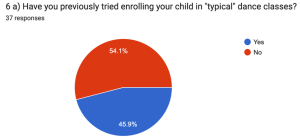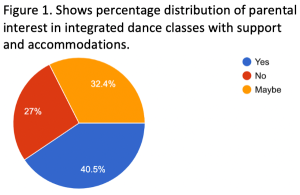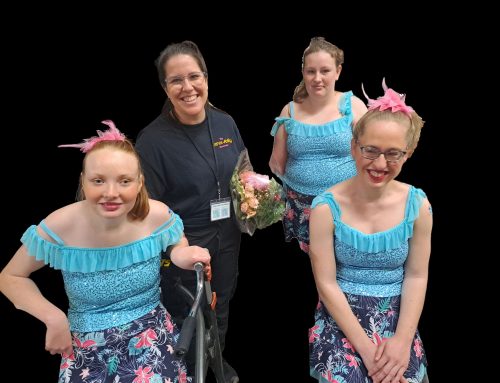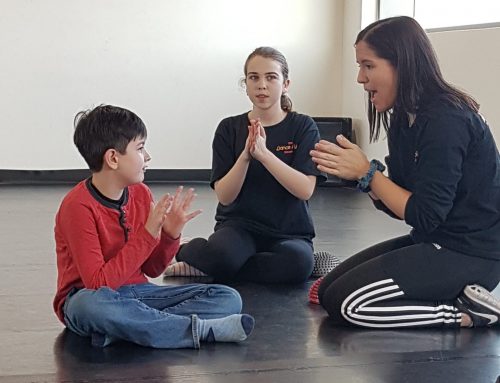At DAM, we hope to create a supportive and inclusive environment where every individual can experience the joy of dance. To better understand the needs and barriers faced by families, studio owners, and dance instructors in fostering inclusivity, we conducted a comprehensive community needs assessment to understand perspectives on creating integrated dance classes. By listening to the voices of our community, we aim to enhance our programs and support integration in dance studios. For this project, we also had the opportunity to collaborate with our student Occupational Therapist, Lovejot; she conducted the project in spring 2024 and wrote the results (including this blog post!) in collaboration with DAM directors. Lovejot collected perspectives of parents, instructors, and studio owners through surveys and interviews. Interviews were conducted with 6 families, 2 studio owners, and 1 dance instructor. Here is an overview of the key findings from our surveys and interviews:
Key Insights from Surveys:
Survey Highlights:
The survey was e-mailed to all active DAM families; 40% of families completed the survey.
- Family Demographics:
- A significant portion of participants were parents of children over 13 years old (67.5%) and survey responses came from parents associated with Dance Elite (34.3% ), The Dance Workshop in Alliston (28.6%), June Lawrence School of Dance (25.7%), and Creative Children’s Dance Centre (11.4%).

Roughly half of respondents had previously tried enrolling their child in “typical” dance classes.
- Importance of Integration and Adaptation:
- 58.3% of parents find it important that their children have opportunities for integration into the broader dance community.
- 75% of parents value the availability of adaptive dance classes specifically for children and youth with disabilities.
- Studio Demographics
- The majority of survey responses were from June Lawrence School of Dance and Dance Elite, each contributing 36.4% of the responses. Out of the respondents, 72.7% were dance instructors and 27.3% were studio owners.
- Notably, 90% of studios had been approached by families seeking inclusive classes.
Barriers to Enrollment in ‘Typical’ Classes:
- Social Isolation: 78% of parents were concerned about the potential social isolation their child with a disability might face
- Focus on ‘typical’ dance expectations: 75% of parents felt that their child might feel out of place due to the class focusing on “typical” dance expectations. Some parents discussed that they could see non-disabled dancers and their families have strong feelings if the class was adapted to the point that they felt their learning and growth were not supported.
- Instructor’s Lack of Awareness and Knowledge: Some parents mentioned that instructors can be exclusionary and have negative attitudes; they emphasized the need for understanding and trained instructors to create a supportive atmosphere.
- 82 % of studio owners and instructors also mentioned that a significant barrier in integration is insufficient training for instructors on inclusive teaching methods.
- 64% of instructors also recognized there is a lack of awareness and understanding of diverse needs amongst staff and students.
- Lack of Support: Concerns about insufficient inclusion and support in typical classes from instructors, peers in the class, and the broader dance community.
- Individual Needs: The necessity for one-on-one assistance or additional personnel and specialized resources that typical classes would not offer.
- Class Pacing: ‘Typical’ classes might move too quickly for some children.
- Financial Constraints: Concerns about potential increased costs for integrated classes.
- Interviews from studio owners and survey responses also indicate that financial constraints affect studios’ ability to hire additional staff and pay for building and equipment modifications; they anticipate that the resources required for integrated classes may result in increased cost for families.
- Negative Experiences: Past discouraging experiences deterred some parents from considering ‘typical ‘classes.
Quote from a Parent: My daughter has been in many different typical programs and some have been fantastic. Too many times though they had her but basically ignored her and when she was younger most of the other kids did too and the space between her and all the others was significant.
Ideal Vision for Inclusive Dance Classes:
- Welcoming and Accepting Environment: Parents emphasize a dance environment characterized by acceptance and positive attitudes from staff, peers, and parents. Dance instructors and studio owners also recognize the importance of ensuring the integrated class has an environment where everyone feels valued and encouraged to participate.

Parental interest in integrated dance classes with support and accommodations.
- Create a New Class/Program with Clear Expectations: It may be beneficial to create a new class or program that is integrated instead of integrating dancers into current typical classes.
- A dance instructor was also in agreement with the idea of creating a new class and discussed that during intake of these classes, clear expectations should be established to ensure that all participants understand the goals and structure of the class.
- Comprehensive Training for Instructors: Provide thorough training for instructors on how to effectively integrate dancers with diverse needs into typical classes. This should include understanding individual needs, learning adaptive teaching methods, classroom management and regulation techniques, and how to foster an inclusive atmosphere.
- Many dance instructor survey respondents strongly emphasized that they would benefit from additional training on inclusivity and to learn how to best support dancers with diverse needs.
- Individualized Support: There needs to be additional volunteer or trained assistance in the room with the instructor, including one-on-one support if needed, to cater to the dancer’s specific needs.
- Instructors and studio owners also share this sentiment; many respondents and interviewees mentioned the importance of having adequate support staff to provide assistance in class.
- Opportunities for Social Interaction and Community Building: There needs to be opportunities for children to build friendships and positive social interactions in a fun and structured environment.
- Balance of Structure and Flexibility: Emphasis on having consistent routines that are part of the class with some flexibility to accommodate diverse needs (i.e. the ability of the dancer to have some autonomy with songs).
Quote from a Parent: Inclusion to me is a dance studio where classes are fully integrated. Accommodations are made for dancers who need them and dancers with disabilities participate fully, are treated equally and are not marginalized. True integration helps build acceptance and understanding. It also helps eliminate fear and false preconceptions.
Current Studio Inclusivity:
- Parents were generally satisfied with their DAM studios’ inclusivity.
- Dance instructors and studio owners discussed that their current inclusivity practices include some studios trying to integrate dancers with disabilities in their typical classes if suitable, referring dancers to external organizations such as DAM, and emphasizing diversity, acceptance, and inclusivity broadly.
- Suggestions to foster inclusivity:
- Some dance instructors and studio owners acknowledged a disconnect between their typical classes and DAM classes. They shared suggestions to increase collaboration between DAM and their broader studio community; through shared communication (e.g., having DAM dancers featured in their newsletter) and hosting shared events to provide all dancers and families a chance to meet each other.
Conclusion
Our community needs assessment has shed light on our community’s values and perspectives around supporting inclusion in dance studios. Findings reaffirm that families value the supportive environment of DAM classes. Efforts could be focused on improving communication and connection with the broader studio community. Studio owners and instructors would like more support to improve inclusion and integration of dancers with disabilities and diverse needs within their studio environment. At DAM, we are committed to ensuring that every child can experience the joy and benefits of dance. By gathering initial perspectives from families, studio owners, and instructors, we’ve gained valuable insights that will help us enhance our programs and support building connections within dance studios. We hope that through sharing these findings, others in the dance community can gain insights into the needs, gaps, and suggestions about inclusive dance practices. We would like to thank the families, instructors, and studio owners who took the time to share their perspectives.


